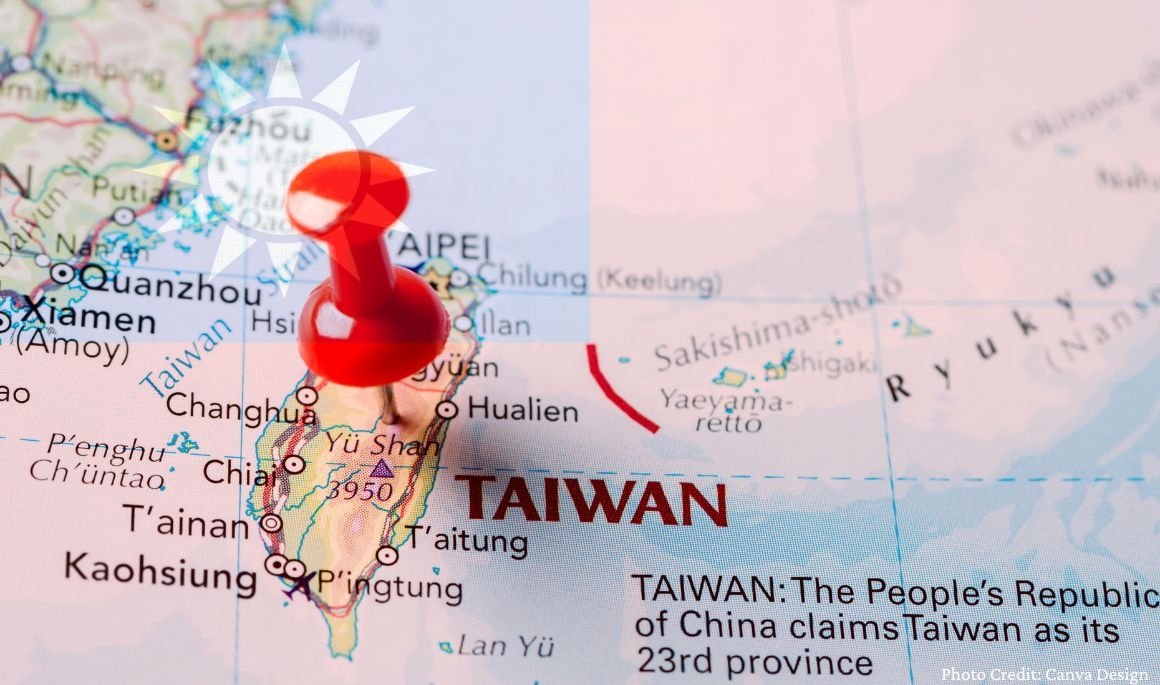- Norwich Blogs
- Blogs
- Imagining a U.S.-China Clash over Taiwan
Imagining a U.S.-China Clash over Taiwan
By Dr. Robert J. Vandenberg
The flashpoint where the U.S. and PRC are most likely to clash is Taiwan. Preventing the Chinese Communist Party (CCP) from taking control of Taiwan has been a cornerstone of U.S. Asia policy since the 1950s, but Washington has declined to endorse the island’s independence outright.

Disclaimer: These opinion pieces represent the authors’ personal views and do not necessarily reflect the official policies or positions of Norwich University or PAWC.
For several decades, the United States has enjoyed a major advantage over the People’s Republic of China (PRC) across all five Joint Functions and their corresponding Air Force Core Mission Areas – Fires/Strike, Intelligence/ISR, Protection/Air Superiority, Movement & Maneuver/Rapid Global Mobility, and Command & Control (C2). However, as highlighted in Aquilino (2023), the Chinese drive for “national rejuvenation” is quickly shifting the balance for at least two of the five (Strike and Air Superiority), which has major implications for a potential conflict between the U.S. and the PRC. The challenge now is to devise approaches to countering China that leverage the continuing advantages the U.S. enjoys with regard to ISR, Mobility, and C2, while also seeking out new capabilities that would enable America to regain leverage in the Strike and Air Superiority domains.
Without question, the flashpoint where the U.S. and PRC are most likely to clash is Taiwan. Preventing the Chinese Communist Party (CCP) from taking control of Taiwan has been a cornerstone of U.S. Asia policy since the 1950s, but Washington has declined to endorse the island’s independence outright. China, meanwhile, has made the seizure of Taiwan its overriding foreign policy objective, growing more confrontational with the island from 2022 onward (Aquilino 2023: 8; Wu and Lai 2025). Furthermore, the Chinese People’s Liberation Army (PLA) has been rapidly modernizing, with a focus on acquiring and expanding precisely those capabilities required to dominate the air and sea around Taiwan and prevent U.S. forces from intervening (CASI 2022; Gill and Ni 2019; Porter and Mazarr 2021; cf. ICG 2021). While the PLA still lacks the force projection capabilities necessary to push further into the Pacific (McPhilamy 2020), the proliferation of highly advanced Anti-Access/Area Denial (A2/AD) missile systems in and around the Taiwan Straits gives them a local overmatch that U.S. forces would be hard-pressed to contest (see Hinote 2022). This is particularly the case regarding Strike and Air Superiority, where the sheer volume of Chinese missiles threatens to render American air power ineffective while holding all forces in the theater at risk. Furthermore, there is reason to believe Beijing may leverage this advantage to move against Taiwan within the next couple of years (Amonson and Egli 2023).
Although conditions now favor China in the Taiwan Strait, the U.S. continues to enjoy significant advantages in Mobility, ISR, and C2. A notable development in U.S. Air Force doctrine has been to leverage mobility to complicate the adversary’s targeting by dispersing forces across a wide range of small contingency bases (USAF 2022). In the case of China, this introduces interesting possibilities when one considers vulnerabilities at sites other than the Taiwan Straits, notably the Indo-Chinese border (Aquilino 2023: 9). Furthermore, although the PLA has likely narrowed the ISR gap by fielding a range of sophisticated intelligence collection systems (CASI 2022), the U.S. retains the benefit of a rigorous and highly professional analytical culture capable of translating data into decision advantage (Dudley 2018). This, in turn, is amplified by a more flexible and adaptable command structure that the PRC, with its intensely centralized institutional culture, is not well positioned to match. McPhilamy (2020) points out that the PLA has been organized for subservience to the CCP at the expense of combat effectiveness, which helps explain why key decisions require the endorsement of both a military commander and a political commissar (CASI 2022). This, combined with chronic corruption and recurring leadership purges (Gan 2024; Jiang and Gan 2024), suggests that the PLA would suffer from a deficit of competent and decisive leadership in a crisis, thus ceding a major C2 advantage to their American and Taiwanese opponents.
When confronted by the implications of China’s missile superiority in the Taiwan Strait, it is tempting to imagine that the solution is to match the PLA missile for missile, but that would be prohibitively expensive. A more viable approach would be to target the networks of systems and personnel that support the Chinese A2/AD architecture and devise ways to attack the network using information operations and information warfare (IO/IW). For years, China has relied on IO/IW to try and circumvent the U.S. advantage in firepower (deLisle 2020; Martin, Shapiro and Nedashkovskaya 2019), but with the PRC now overtaking the U.S. in at least some conventional capabilities, the question then becomes how to use the information domain to paralyze their forces. Fortunately, the Chinese command structure presents an inviting target, since it is optimized for central control over combat effectiveness and prioritizes loyalty and accountability over flexibility and initiative. For this reason, IO/IW capabilities targeting C2 systems associated with A2/AD weapons could paralyze them simply by leaving their operators uncertain about what orders to execute. More sophisticated versions of this could involve sowing misinformation throughout the Chinese chain of command, sowing mistrust across different echelons and between coequal commissars and commanders within the same echelon (see: Hall 2023). With 80 years of CCP discipline backed up by several more millennia of imperial Chinese centralization, junior and mid-level PLA officers would be unprepared to operate based on the commander’s intent rather than clear direction from above. This, then, is likely America’s greatest tactical advantage in a conflict over Taiwan, and one that we should be prepared to exploit to the full.
Robert J. Vandenberg, Ph.D. is a sociologist and criminologist specializing in the study of political violence and a senior fellow at the John and Mary Frances Patton Peace and War Center. A serving officer in the United States Air Force, Dr. VandenBerg previously taught on the faculty at Norwich University, where he oversaw the creation of the academic program in Intelligence and Crime Analysis. The opinions expressed in this essay are the author’s own and do not represent the official position of the United States Government, the Department of Defense, or the Air Force. This paper was originally written as part of coursework for Air Command and Staff College.
Works Cited
Amonson, Kyle, and Dane Egli. 2023. “The Ambitious Dragon: Beijing’s Calculus for Invading Taiwan by 2030.” Journal of Indo-Pacific Affairs 6(3): 38-54.
Aquilino, John C. 2023. Statement of Admiral John C. Aquilino, U.S. Navy, Commander, U.S. Indo-Pacific Command, U.S. Indo-Pacific Command Posture, 18 April 2023. United States Congress, https://www.congress.gov/118/meeting/house/115680/witnesses/HHRG-118-AS00-Wstate-AquilinoJ-20230418.pdf.
China Aerospace Studies Institute (CASI). 2022. PLA Aerospace Power: A Primer on Trends in China’s Military Air, Space, and Missile Forces (third edition). Montgomery, AL: Air University.
deLisle, Jacques. 2020. “Foreign Policy through Other Means: Hard Power, Soft Power, and China’s Turn to Political Warfare to Influence the United States.” Orbis 64(2): 174-206.
Dudley, Craig A. 2018. “Information-Centric Intelligence: The Struggle in Defining National Security Issues.” International Journal of Intelligence and CounterIntelligence 31(4): 758-768.
Gan, Nectar. 2024. “Xi’s Latest Purge Targets the Military. Why Did Powerful Generals Fall Out of Favor?” Cable News Network, January 5, https://edition.cnn.com/2024/01/05/china/ china-xi-military-purge-analysis-intl-hnk/index.html (accessed January 8, 2024).
Gill, Bates, and Adam Ni. 2019. “China’s Sweeping Military Reforms.” Security Challenges 15(1): 33-46.
Hall, Daniel S. 2023. “America Must Engage in the Fight for Strategic Cognitive Terrain.” Joint Force Quarterly 108: 75-86.
Hinote, S. Clinton. 2022. “After Defeat: A Time to Rebuild.” Æther 1(1): 22-34.
International Crisis Group (ICG). 2021. Competing Visions of International Order in the South China Sea. Brussels, Belgium.
Jiang, Steven, and Nectar Gan. 2024. “China Investigates a Top Military Official as Xi Broadens Purge of PLA Generals.” Cable News Network, November 28, https://edition.cnn.com/ 2024/11/28/china/china-military-general-investigation-intl-hnk (accessed November 29, 2024).
McPhilamy, Jonathan G. 2020. “Air Supremacy: Are the Chinese Ready?” Military Review 100(1): 56-61.
Porter, Patrick, and Michael Mazarr. 2021. Countering China’s Adventurism over Taiwan: A Third Way. Sydney, Australia: Lowy Institute for International Policy.
United States Air Force (USAF). 2022. Air Force Doctrine Note 1-21: Agile Combat Employment. Maxwell Air Force Base, AL: Curtis E. LeMay Center for Doctrine Development and Education.
Wu, Huizhong, and Johnson Lai. 2025. “Chinese Military Conducts Large-Scale Drills Around Taiwan.” Associated Press, April 2, https://apnews.com/article/china-taiwan-military-drills-56a39e0044657c0a74482184895e6bed (accessed June 19, 2025).



